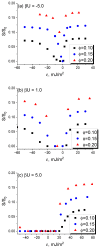Effect of the Interplay between Polymer-Filler and Filler-Filler Interactions on the Conductivity of a Filled Diblock Copolymer System
- PMID: 38201769
- PMCID: PMC10781002
- DOI: 10.3390/polym16010104
Effect of the Interplay between Polymer-Filler and Filler-Filler Interactions on the Conductivity of a Filled Diblock Copolymer System
Abstract
We investigate the relative roles of the involved interactions and micro-phase morphology in the formation of the conductive filler network in an insulating diblock copolymer (DBC) system. By incorporating the filler immersion energy obtained by means of the phase-field model of the DBC into the Monte Carlo simulation of the filler system, we determined the equilibrium distribution of fillers in the DBC that assumes the lamellar or cylindrical (hexagonal) morphology. Furthermore, we used the resistor network model to calculate the conductivity of the simulated filler system. The obtained results essentially depend on the complicated interplay of the following three factors: (i) Geometry of the DBC micro-phase, in which fillers are preferentially localized; (ii) difference between the affinities of fillers for dissimilar copolymer blocks; (iii) interaction between fillers. The localization of fillers in the cylindrical DBC micro-phase has been found to most effectively promote the conductivity of the composite. The effect of the repulsive and attractive interactions between fillers on the conductivity of the filled DBC has been studied in detail. It is quantitatively demonstrated that this effect has different significance in the cases when the fillers are preferentially localized in the majority and minority micro-phases of the cylindrical DBC morphology.
Keywords: conductivity; diblock copolymers; filler.
Conflict of interest statement
The authors declare no conflict of interest. The funders had no role in the design of the study; in the collection, analyses, or interpretation of data; in the writing of the manuscript; or in the decision to publish the results.
Figures



Similar articles
-
Conductivity of Filled Diblock Copolymer Systems: Identifying the Main Influencing Factors.Polymers (Basel). 2025 May 28;17(11):1502. doi: 10.3390/polym17111502. Polymers (Basel). 2025. PMID: 40508745 Free PMC article.
-
Temperature dependence of the conductivity of filled diblock copolymers.Phys Rev E. 2020 Nov;102(5-1):052504. doi: 10.1103/PhysRevE.102.052504. Phys Rev E. 2020. PMID: 33327154
-
Conductivity of Insulating Diblock Copolymer System Filled with Conductive Particles Having Different Affinities for Dissimilar Copolymer Blocks.Polymers (Basel). 2020 Jul 25;12(8):1659. doi: 10.3390/polym12081659. Polymers (Basel). 2020. PMID: 32722506 Free PMC article.
-
A Review of Polymer Composites Based on Carbon Fillers for Thermal Management Applications: Design, Preparation, and Properties.Polymers (Basel). 2021 Apr 16;13(8):1312. doi: 10.3390/polym13081312. Polymers (Basel). 2021. PMID: 33923627 Free PMC article. Review.
-
Review of the Performance of High-Voltage Composite Insulators.Polymers (Basel). 2022 Jan 21;14(3):431. doi: 10.3390/polym14030431. Polymers (Basel). 2022. PMID: 35160421 Free PMC article. Review.
Cited by
-
Conductivity of Filled Diblock Copolymer Systems: Identifying the Main Influencing Factors.Polymers (Basel). 2025 May 28;17(11):1502. doi: 10.3390/polym17111502. Polymers (Basel). 2025. PMID: 40508745 Free PMC article.
References
-
- Chiu J.J., Kim B.J., Yi G.R., Bang J., Kramer E.J., Pine D.J. Distribution of nanoparticles in lamellar domains of block copolymers. Macromolecules. 2007;40:3361–3365. doi: 10.1021/ma061503d. - DOI
-
- Kim B.J., Fredrickson G.H., Kramer E.J. Effect of Polymer Ligand Molecular Weight on Polymer-Coated Nanoparticle Location in Block Copolymers. Macromolecules. 2008;41:436–447. doi: 10.1021/ma701931z. - DOI
-
- Diaz J., Pinna M., Zvelindovsky V.A., Pagonabarraga I. Phase Behavior of Block Copolymer Nanocomposite Systems. Adv. Theory Simul. 2018;1:1800066. doi: 10.1002/adts.201800066. - DOI
Grants and funding
LinkOut - more resources
Full Text Sources

